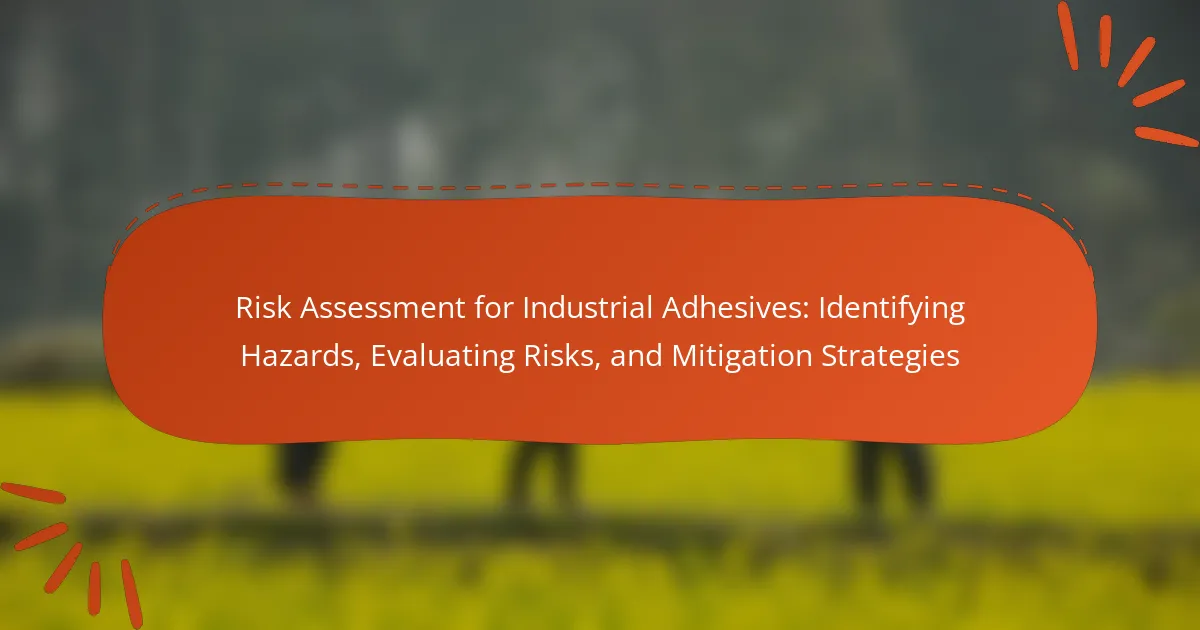Fire safety considerations for industrial adhesives focus on critical factors such as flash points, proper storage practices, and effective firefighting measures. Flash points indicate the temperature at which adhesives can ignite, necessitating stringent handling protocols for those with low flash points. Key strategies for ensuring fire safety include maintaining well-ventilated storage areas, using appropriate containers, and conducting regular employee training on fire safety protocols. Adhering to safety data sheets and implementing guidelines from the National Fire Protection Association (NFPA) further enhance safety measures, helping to mitigate fire risks associated with adhesive applications.

What are Fire Safety Considerations for Industrial Adhesives?
Fire safety considerations for industrial adhesives include understanding flash points and proper storage practices. Flash points indicate the temperature at which an adhesive can ignite. Adhesives with low flash points require special handling to prevent fires. Proper ventilation is essential in storage areas to dissipate flammable vapors. Firefighting measures should include accessible fire extinguishers suitable for chemical fires. Training employees on fire safety protocols is crucial. Regular inspections of storage facilities help identify potential hazards. Using non-flammable or low-flammability adhesives can enhance safety. Adhering to safety data sheets ensures compliance with fire safety regulations.
Why are flash points important in fire safety for industrial adhesives?
Flash points are crucial in fire safety for industrial adhesives because they indicate the temperature at which a substance can ignite. Understanding flash points helps in assessing the flammability risk of adhesives during storage and application. Adhesives with low flash points pose a higher risk of catching fire in warm environments. This knowledge allows for the implementation of appropriate safety measures, such as proper ventilation and temperature control. According to the National Fire Protection Association, materials with flash points below 100°F are classified as flammable. Hence, knowing the flash point aids in selecting safer adhesive options for industrial environments.
What defines the flash point of an industrial adhesive?
The flash point of an industrial adhesive is defined as the lowest temperature at which it can form an ignitable mixture with air. This temperature indicates the adhesive’s volatility and potential fire hazard. Adhesives with lower flash points are more flammable and require careful handling. The flash point is determined through standardized testing methods, such as the closed cup or open cup tests. These tests measure the temperature at which vapors ignite when exposed to an ignition source. Understanding the flash point is crucial for safety protocols in industrial settings. It helps in selecting appropriate adhesives for specific applications and informs storage and usage guidelines.
How can flash points vary among different types of industrial adhesives?
Flash points can vary significantly among different types of industrial adhesives. For example, solvent-based adhesives typically have lower flash points, often between 20°C to 40°C. In contrast, water-based adhesives generally possess higher flash points, often exceeding 60°C. Hot melt adhesives can also show variability, with flash points that can reach up to 300°C depending on their formulation. The chemical composition of the adhesive directly influences its flash point. Adhesives containing flammable solvents will have lower flash points compared to those that are solvent-free. Understanding these differences is crucial for ensuring safe handling and storage.
What firefighting measures should be implemented for industrial adhesives?
Firefighting measures for industrial adhesives include the use of appropriate extinguishing agents and safety protocols. Water can be used for cooling containers but may not extinguish all adhesive fires effectively. Foam extinguishers are recommended for flammable liquid adhesives. Dry chemical extinguishers can also be effective against adhesive fires. Firefighters should wear protective gear to prevent exposure to toxic fumes. Adequate ventilation is crucial to disperse flammable vapors. Fire safety training for employees is essential to ensure proper response during emergencies. Regular inspections of firefighting equipment should be conducted to maintain readiness.
What types of extinguishing agents are effective for adhesive fires?
Foam, dry chemical, and carbon dioxide are effective extinguishing agents for adhesive fires. Foam suppresses flames by creating a barrier between the fuel and oxygen. Dry chemical agents interrupt the chemical reaction in the fire. Carbon dioxide displaces oxygen, suffocating the fire. Each agent targets different aspects of the fire, enhancing effectiveness. The National Fire Protection Association (NFPA) recommends these agents for specific adhesive types. Proper selection is critical for effective firefighting.
How should personnel be trained for firefighting in adhesive-related incidents?
Personnel should be trained in specific techniques for firefighting in adhesive-related incidents. Training should include understanding the properties of adhesives and their flash points. Personnel must learn to identify the types of adhesives present in the workplace. They should be educated on the appropriate extinguishing agents for adhesive fires. Knowledge of personal protective equipment (PPE) is crucial for safety during firefighting. Simulated drills should be conducted to practice response to adhesive-related fires. Regular refresher courses should be implemented to keep skills updated. Compliance with OSHA standards can provide a framework for training programs.
What preventative strategies can be employed to enhance fire safety?
Preventative strategies to enhance fire safety include implementing proper storage practices for industrial adhesives. Store adhesives in cool, well-ventilated areas away from ignition sources. Regularly inspect storage areas for leaks or spills. Maintain clear access to fire extinguishers and ensure they are regularly serviced. Conduct fire safety training for employees to recognize hazards and respond effectively. Install smoke detectors and fire alarms to provide early warning. Establish an emergency response plan tailored to specific materials used. These strategies significantly reduce the risk of fire incidents in industrial settings.
How can proper storage of industrial adhesives reduce fire risk?
Proper storage of industrial adhesives can significantly reduce fire risk by minimizing exposure to ignition sources. Industrial adhesives often contain flammable solvents that can ignite easily. Storing these adhesives in a cool, dry place away from heat sources lowers the chance of accidental ignition. Additionally, using appropriate containers that are sealed and labeled prevents leaks and spills that could create fire hazards.
Maintaining proper ventilation in storage areas helps dissipate any vapors that may accumulate, further reducing the risk of fire. According to the National Fire Protection Association, proper storage practices can decrease the likelihood of fire incidents in industrial settings. Implementing these storage strategies ensures a safer work environment and compliance with safety regulations.
What role does workplace design play in fire safety for adhesives?
Workplace design significantly influences fire safety for adhesives. Proper layout minimizes the risk of fire hazards. Adequate ventilation reduces flammable vapors from accumulating. Designated storage areas for adhesives prevent cross-contamination and potential ignition sources. Fire-resistant materials in construction enhance overall safety. Clear access to emergency exits facilitates quick evacuation during incidents. Regular safety audits in the design process ensure compliance with fire safety regulations. Research indicates that well-designed workplaces can lower incident rates by up to 30%.

How do flash points impact fire safety protocols for industrial adhesives?
Flash points significantly impact fire safety protocols for industrial adhesives. Flash points indicate the minimum temperature at which an adhesive can vaporize to form an ignitable mixture in air. Adhesives with low flash points require stricter handling and storage protocols to prevent ignition. These protocols include maintaining lower storage temperatures and using explosion-proof equipment. Additionally, proper labeling and safety data sheets are essential for informing workers about risks. Training programs must emphasize flash point awareness to enhance safety practices. Regulatory standards often mandate specific measures based on an adhesive’s flash point. For instance, materials with flash points below 100°F are classified as flammable and necessitate special precautions. These measures aim to mitigate fire hazards and ensure a safe working environment.
What are the key factors influencing the flash point of adhesives?
The key factors influencing the flash point of adhesives include chemical composition, viscosity, and presence of solvents. Chemical composition determines the flammability of the adhesive. For instance, adhesives with higher concentrations of volatile organic compounds (VOCs) typically have lower flash points. Viscosity affects how easily the adhesive can vaporize. Lower viscosity adhesives tend to have lower flash points. The presence of solvents also plays a significant role. Solvents can evaporate at lower temperatures, contributing to a lower flash point. Additionally, temperature and pressure conditions during storage can influence the flash point. Understanding these factors is crucial for ensuring fire safety in industrial applications.
How does temperature affect the flash point of industrial adhesives?
Temperature significantly influences the flash point of industrial adhesives. As temperature increases, the flash point typically decreases. This is due to the fact that higher temperatures provide more energy, allowing adhesive vapors to ignite more easily. For example, many adhesives have a flash point below 100°F (37.8°C), making them flammable at room temperature. Conversely, lowering the temperature can raise the flash point, reducing the risk of ignition. Understanding this relationship is crucial for safe storage and application of adhesives in industrial settings.
What testing methods are used to determine flash points?
The testing methods used to determine flash points include the closed cup method and the open cup method. The closed cup method measures the temperature at which vapors ignite in a sealed environment. This method is often more accurate for volatile substances. The open cup method involves measuring the flash point in an open container. This method can be less precise due to environmental factors. Additionally, the Pensky-Martens and Tag methods are standardized procedures for testing flash points. These methods are widely accepted in industrial settings for safety assessments.
How can understanding flash points improve firefighting strategies?
Understanding flash points can significantly improve firefighting strategies. Flash points indicate the lowest temperature at which a substance can vaporize to form an ignitable mixture in air. Knowing the flash points of materials helps firefighters prioritize their response. It allows them to identify which substances pose the greatest risk during a fire. For instance, materials with low flash points ignite more easily and require immediate attention. This understanding aids in selecting appropriate extinguishing agents. Firefighters can use water, foam, or dry chemicals based on the type of material involved. Proper training on flash points enhances situational awareness during emergencies. Statistics show that effective firefighting strategies reduce fire damage and improve safety outcomes.
What specific firefighting techniques are recommended based on flash point data?
Firefighting techniques recommended based on flash point data include cooling, smothering, and extinguishing. Cooling involves applying water or foam to reduce temperature and prevent ignition. Smothering techniques use foam or dry chemicals to cut off oxygen supply, effectively extinguishing flames. Extinguishing methods vary depending on the flash point; for low flash point materials, water mist is effective, while high flash point materials may require foam or dry chemical agents. These techniques are validated by the National Fire Protection Association (NFPA) guidelines, which emphasize using appropriate agents based on the specific flash point of the material involved.
How does flash point awareness influence emergency response planning?
Flash point awareness significantly influences emergency response planning by determining the safe handling and storage of flammable materials. Understanding the flash point allows responders to identify potential fire hazards. It informs the selection of appropriate firefighting measures. For example, materials with low flash points require specific extinguishing agents. Emergency plans incorporate these details to minimize risks. Additionally, flash point data guides evacuation procedures and safety training. This ensures that personnel are aware of the dangers. The National Fire Protection Association (NFPA) emphasizes the importance of flash point knowledge in their safety standards.

What are the best practices for ensuring fire safety in adhesive applications?
Implementing best practices for fire safety in adhesive applications involves several key strategies. First, ensure proper storage of adhesives in cool, well-ventilated areas. This reduces the risk of ignition from heat sources. Second, utilize appropriate containers that are resistant to fire. Using fire-rated cabinets can help contain potential fires. Third, maintain clear labeling of all adhesive products, including their flash points. This information is critical for safe handling and emergency response.
Fourth, conduct regular training for employees on fire safety protocols. Training should include the use of fire extinguishers and understanding material safety data sheets (MSDS). Fifth, install proper ventilation systems to minimize the accumulation of flammable vapors. This is essential in areas where adhesives are applied or stored. Lastly, implement a strict no-smoking policy in areas where adhesives are used. This significantly reduces the risk of accidental ignition.
These practices align with guidelines from the National Fire Protection Association (NFPA), which emphasizes the importance of fire safety in industrial settings. Following these best practices can help mitigate fire risks associated with adhesive applications.
What regular maintenance practices can prevent fire hazards?
Regular maintenance practices that can prevent fire hazards include inspecting and cleaning equipment regularly. This includes checking for frayed wires, leaks, and other wear and tear. Proper storage of flammable materials is essential. Store them in approved containers away from heat sources. Ensure that fire extinguishers are accessible and serviced annually. Maintain clear exit routes and keep them free of obstructions. Conduct routine fire drills to ensure readiness. Regularly test smoke detectors and alarms to ensure functionality. These practices significantly reduce the risk of fire incidents in industrial settings.
How often should fire safety audits be conducted in facilities using adhesives?
Fire safety audits in facilities using adhesives should be conducted at least annually. This frequency is recommended to ensure compliance with safety regulations and to identify potential hazards. Adhesives can pose significant fire risks due to their chemical properties. Regular audits help in assessing storage conditions and handling procedures. Additionally, audits should be performed after any significant changes in operations or materials. This practice aligns with guidelines from organizations such as the National Fire Protection Association (NFPA). They emphasize the importance of proactive safety measures in high-risk environments. Regular audits can significantly reduce the likelihood of fire incidents.
What safety equipment is essential for handling industrial adhesives?
Essential safety equipment for handling industrial adhesives includes gloves, goggles, and respirators. Gloves protect hands from skin contact with adhesives. Goggles safeguard eyes from splashes and fumes. Respirators filter harmful vapors during application. Additionally, protective clothing prevents adhesive contact with skin. Fire extinguishers should be readily available in case of fire. Proper ventilation systems minimize inhalation of harmful fumes. Safety data sheets provide critical information on specific adhesives. Following these safety measures reduces the risk of accidents and injuries.
What common mistakes should be avoided to enhance fire safety?
Common mistakes to avoid for enhancing fire safety include neglecting proper storage of flammable materials. Flammable substances should be stored in designated, well-ventilated areas away from ignition sources. Failing to conduct regular fire risk assessments can lead to unidentified hazards. Regular assessments help identify and mitigate risks effectively.
Another mistake is not providing adequate fire safety training for employees. Training ensures that staff are aware of fire hazards and emergency procedures. Ignoring maintenance of fire safety equipment, such as extinguishers and alarms, can compromise safety. Equipment should be routinely inspected and maintained to ensure functionality.
Additionally, overcrowding workspaces can obstruct escape routes and increase fire risk. Ensuring clear pathways and exits is essential for safety. Lastly, overlooking the importance of proper labeling of hazardous materials can lead to confusion during emergencies. Clear labeling helps in quick identification and response to fire hazards.
How can improper labeling of adhesives lead to fire risks?
Improper labeling of adhesives can lead to fire risks by failing to communicate their flammability. Adhesives often contain volatile organic compounds that are highly combustible. If users are unaware of these properties, they may use them near open flames or heat sources. This negligence can result in ignition, causing fires. The National Fire Protection Association (NFPA) emphasizes the importance of accurate labeling for hazardous materials. Mislabeling might also lead to incorrect storage practices, further increasing fire hazards. Inadequate information can prevent users from taking necessary precautions. Proper labeling is essential for ensuring safety in industrial environments.
What are the consequences of neglecting safety data sheets (SDS)?
Neglecting safety data sheets (SDS) can lead to serious consequences. Employees may be unaware of the hazards associated with chemicals. This ignorance increases the risk of accidents and injuries in the workplace. Inadequate training may occur due to missing information on safe handling. Regulatory non-compliance can result in fines and legal penalties. Emergency response may be hindered without proper SDS access. Furthermore, neglecting SDS can damage a company’s reputation. Ultimately, this neglect compromises workplace safety and health.
What are practical tips for improving fire safety with industrial adhesives?
Use industrial adhesives with low flash points to enhance fire safety. Low flash point adhesives ignite at higher temperatures, reducing fire risks. Store adhesives in cool, well-ventilated areas away from heat sources. This limits exposure to potential ignition points. Implement proper labeling of adhesive containers. Clear labeling helps identify hazards quickly during emergencies. Train employees on fire safety protocols related to adhesive use. Regular training ensures awareness and preparedness. Use fire-resistant storage cabinets for flammable adhesives. These cabinets contain fires and prevent them from spreading. Regularly inspect adhesive storage areas for leaks or spills. Immediate cleanup of spills reduces fire hazards. Maintain proper ventilation in workspaces where adhesives are used. Good airflow disperses flammable vapors, minimizing fire risks.
The main entity of this article is fire safety considerations for industrial adhesives, with a focus on flash points, firefighting measures, and preventative strategies. The article outlines the importance of understanding flash points in assessing the flammability of adhesives, proper storage practices to minimize fire risks, and effective firefighting techniques tailored to different adhesive types. It emphasizes the necessity of employee training on fire safety protocols and regular inspections to identify hazards. Additionally, the article discusses the role of workplace design and regular maintenance practices in enhancing fire safety in industrial settings.



